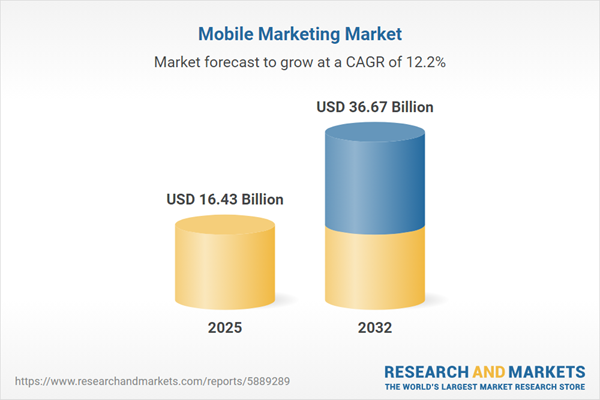Speak directly to the analyst to clarify any post sales queries you may have.
The mobile marketing market is evolving rapidly as enterprises adapt to digital-first consumer expectations and expanded regulatory oversight. Senior leaders must align operational agility, technology integration, and compliance measures to consistently achieve competitive gains.
Market Snapshot: Mobile Marketing Market Growth and Outlook
The mobile marketing market is projected to advance from USD 14.63 billion in 2024 to USD 16.43 billion in 2025, reflecting a strong CAGR of 12.16 percent. Market forecasts indicate a surge to USD 36.67 billion by 2032. This growth is driven by widespread adoption of mobile devices across consumer and business segments, intensifying digital touchpoints and engagement. Market participants are leveraging artificial intelligence and machine learning to optimize mobile campaigns, enhance personalization, and streamline targeting. Trends such as increasing mobile-first initiatives, advanced compliance practices, and innovative ad formats are shaping strategic outcomes. Technology responsiveness and proactive regulatory strategies remain critical for sustaining market momentum as competitive intensity rises.
Scope & Segmentation: Strategic Drivers in the Mobile Marketing Market
- Device Types: Smartphones and tablets serve as vital hubs for interactive marketing initiatives, closely linked to evolving digital behaviors and consumption patterns.
- Channels: In-app placements—especially in gaming and productivity environments—capture user attention during peak activity, while mobile web advertising enables rapid delivery of key brand messages to diverse audiences.
- Operating Systems: Tailored campaign design for Android and iOS platforms allows organizations to align communication with audience preferences and adapt to unique system-level requirements.
- Ad Formats: Display banners, interstitials, video, native, and rich media formats offer both scale and versatility, ensuring campaign objectives are met across various engagement scenarios.
- End User Industries: Automotive, financial services, insurance, healthcare, and retail sectors use mobile marketing to accelerate market presence, improve compliance management, and amplify digital engagement with key client groups.
- Regions: Americas, EMEA, and Asia-Pacific each present unique growth opportunities and operational considerations, shaped by local regulatory environments, infrastructure variance, and shifting user expectations.
- Leading Companies: Google LLC, Meta Platforms, ByteDance Ltd., Amazon.com, Snap Inc., Microsoft, Verizon, The Trade Desk, Criteo, and Unity Software drive sector innovation in privacy, measurement, and campaign execution.
Key Takeaways: Actionable Insights for Senior Leaders
- Utilizing AI-powered analytics enables organizations to quickly adapt mobile campaigns in response to user behavior changes, boosting audience relevance and engagement.
- Embedding robust data privacy and compliance protocols into all levels of marketing strategy maintains regulatory alignment and supports consistent operations across regions.
- Integrating messaging across mobile, in-app, and web platforms fosters unified brand experiences, contributing to improved retention and loyalty.
- Approaching creative development and targeting on a device- and platform-specific basis helps address sector and regional demands for ongoing relevance.
- Proactively monitoring evolving regulatory environments and adjusting internal processes mitigates risk and strengthens operational continuity.
- Investing in flexible technology platforms and industry alliances ensures faster response to market shifts and changing end-user standards.
Tariff Impact: Navigating 2025 U.S. Tariffs in Mobile Marketing
Forthcoming 2025 U.S. tariffs are changing cost structures and supply chain processes for mobile marketing manufacturers and ad tech firms. Senior teams are undertaking comprehensive sourcing evaluations and refining operational infrastructure. Scenario planning is now central to predicting business impacts and adapting quickly. Organizational agility and a proactive approach are essential to maintain marketing performance and minimize disruption during regulatory transitions.
Methodology & Data Sources
This research leverages extensive market datasets, in-depth regulatory analyses, industry expert interviews, and practitioner surveys. Data cross-validation ensures reliable insights for strategic planning and execution within the mobile marketing market.
Why This Report Matters: Strategic Utility for Decision-Makers
- Aligns mobile marketing market strategies with current technology trends and compliance demands, supporting efficient execution across all regions.
- Prepares senior teams to anticipate and manage market complexity stemming from regulatory changes, trade policies, or supply chain disruptions using scenario-based planning.
- Delivers practical recommendations to drive platform efficiency and increase measurable client engagement.
Conclusion
To excel in the mobile marketing market, leaders must blend advanced technology, rigorous compliance, and precision targeting. This approach ensures the adaptability and resilience required to address evolving market challenges.
Additional Product Information:
- Purchase of this report includes 1 year online access with quarterly updates.
- This report can be updated on request. Please contact our Customer Experience team using the Ask a Question widget on our website.
Table of Contents
3. Executive Summary
4. Market Overview
7. Cumulative Impact of Artificial Intelligence 2025
Companies Mentioned
The companies profiled in this Mobile Marketing market report include:- Google LLC
- Meta Platforms, Inc.
- ByteDance Ltd.
- Amazon.com, Inc.
- Snap Inc.
- Microsoft Corporation
- Verizon Communications Inc.
- The Trade Desk, Inc.
- Criteo S.A.
- Unity Software Inc.
Table Information
| Report Attribute | Details |
|---|---|
| No. of Pages | 199 |
| Published | October 2025 |
| Forecast Period | 2025 - 2032 |
| Estimated Market Value ( USD | $ 16.43 Billion |
| Forecasted Market Value ( USD | $ 36.67 Billion |
| Compound Annual Growth Rate | 12.1% |
| Regions Covered | Global |
| No. of Companies Mentioned | 11 |









